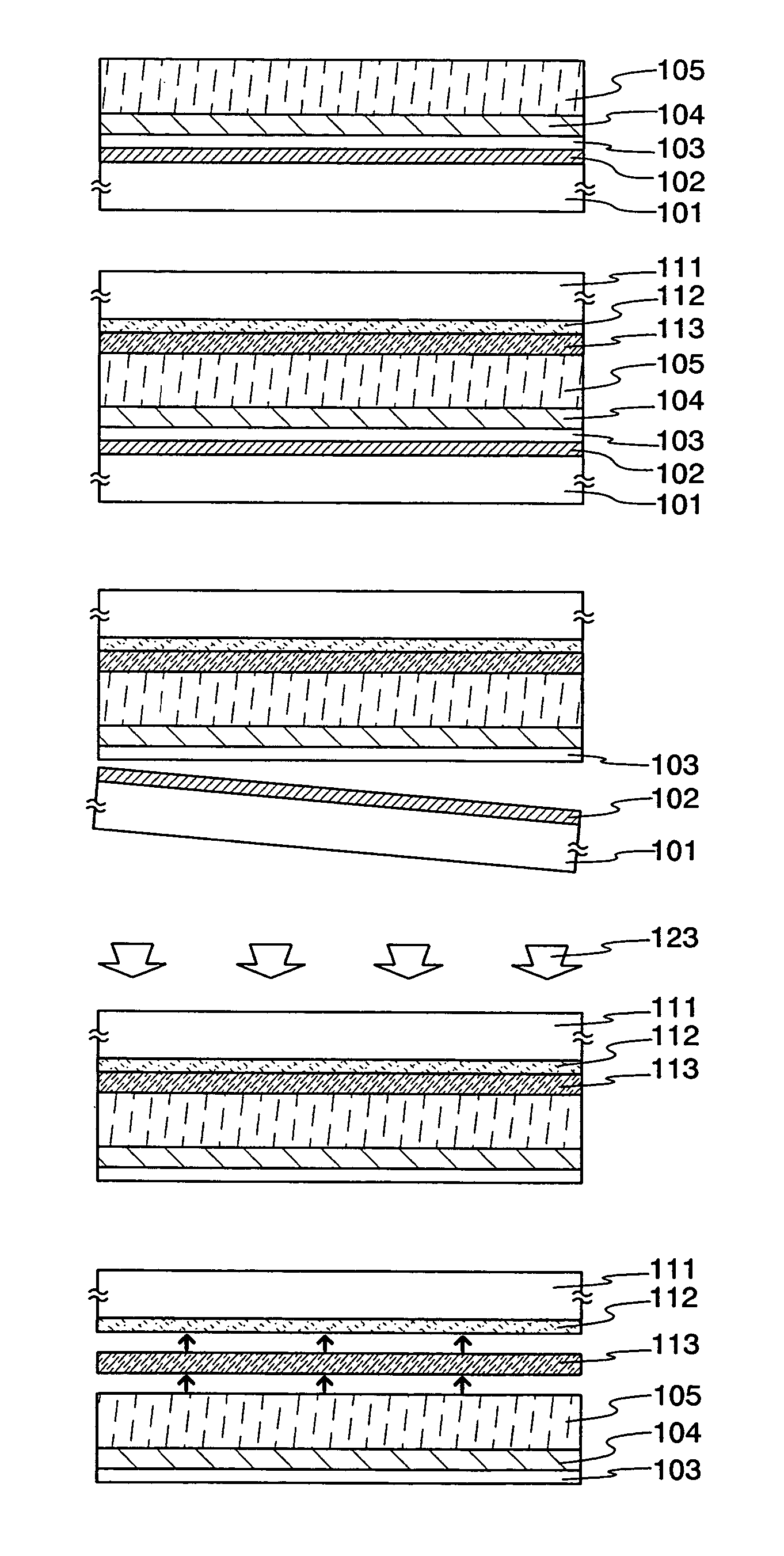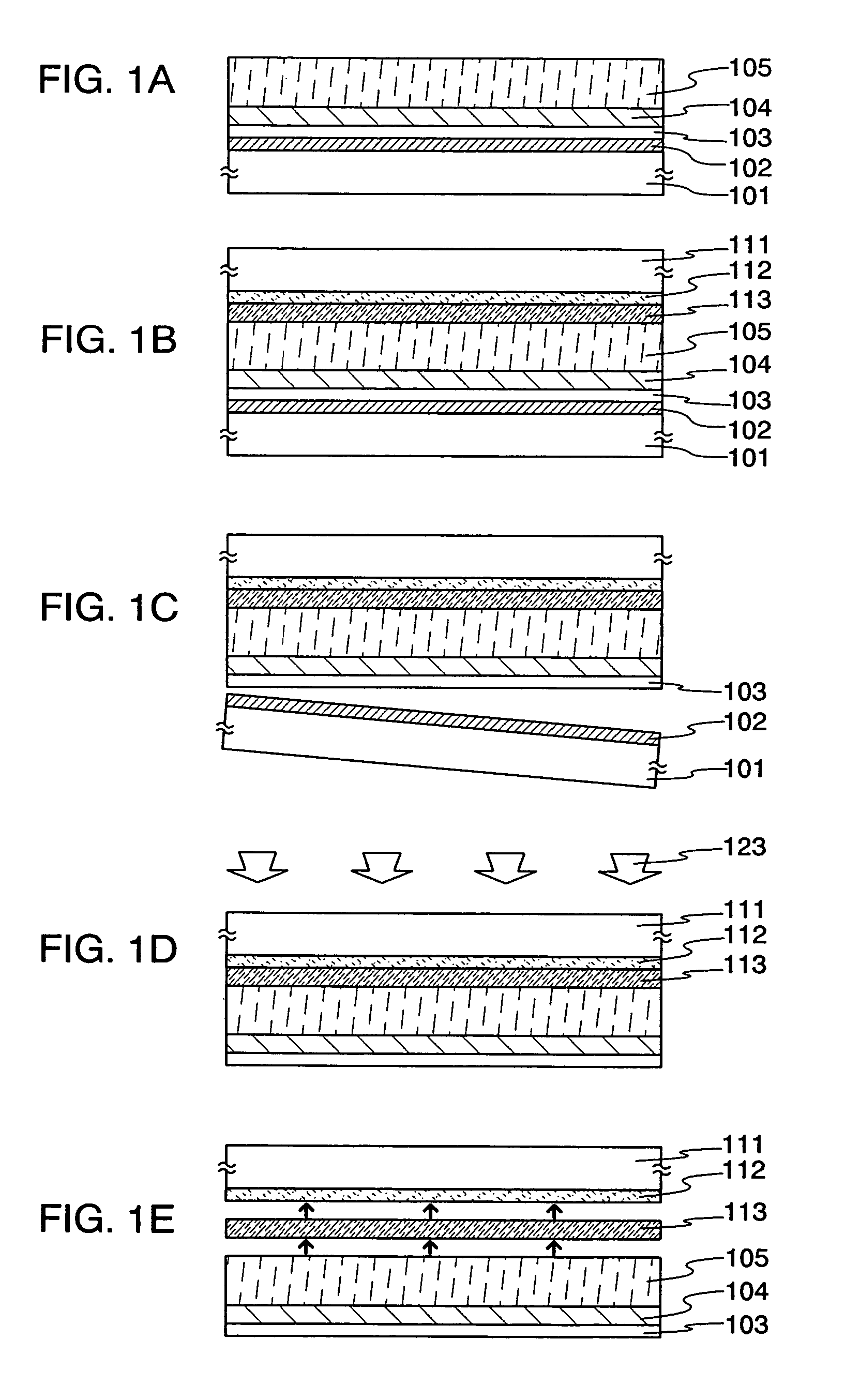Method for manufacturing semiconductor device
a manufacturing method and semiconductor technology, applied in the direction of semiconductor devices, basic electric elements, electrical equipment, etc., can solve the problems of unsuitable mass production, high production cost, and low yield of substrates, and achieve excellent impact resistance properties and high yield
- Summary
- Abstract
- Description
- Claims
- Application Information
AI Technical Summary
Benefits of technology
Problems solved by technology
Method used
Image
Examples
embodiment mode 1
[Embodiment Mode 1]
[0041]In the present embodiment mode, a method of separating a lamination body formed over a substrate will be described with reference to FIGS. 1A to 1E.
[0042]As shown in FIG. 1A, a metal film 102 is formed on a first substrate 101. As the first substrate, a heat-resistant substrate, i.e., a material that can withstand the heat treatment in a step of manufacturing an optical filter formed later and the separation step, typically, a glass substrate, a quartz substrate, a ceramic substrate, a silicon substrate, a metal substrate, or a stainless substrate can be used.
[0043]The metal film 102 may be formed of an element selected from titanium (Ti), aluminum (Al), tantalum (Ta), tungsten (W), molybdenum (Mo), copper (Cu), chromium (Cr), neodymium (Nd), iron (Fe), nickel (Ni), cobalt (Co), ruthenium (Ru), rhodium (Rh), palladium (Pd), osmium (Os), iridium (Ir); a single layer formed of an alloy material containing the above-mentioned elements as its main constituent; o...
embodiment 1
[Embodiment 1]
[0064]In the present embodiment, a method of manufacturing a semiconductor device using Embodiment Mode 1 will be described with reference to FIGS. 3A to 3E and FIGS. 4A to 4D.
[0065]As shown in FIG. 3A, a metal film 302 (e.g., a tungsten film with a thickness of 10 to 200 nm, preferably, 30 to 75 nm) is formed on a first substrate 301. The metal film is heated to form an oxide film 303 (e.g., a tungsten oxide film) with a thickness of 1 to 10 nm, preferably, 2 to 5 nm.
[0066]Since the tungsten film and the tungsten oxide film are also formed on edge surfaces of the substrate by sputtering, they are preferably and selectively removed therefrom by O2 ashing etc.
[0067]An anti-reduction film 304 is formed by sputtering. In the embodiment, an AlNxOy film is formed by using an aluminum nitride (AlN) target under an atmosphere of containing a mixture of argon gas, nitrogen gas, and oxygen gas. A first insulating film 305, e.g., a silicon oxynitride film, is next laminated by P...
embodiment mode 2
[Embodiment Mode 2]
[0092]The present embodiment will explain a method of manufacturing a semiconductor device having an inverted-stagger type TFT with reference to FIGS. 5A to 5D, and FIGS. 6A to 6E.
[0093]As shown in FIG. 5A, a metal film 302 with a thickness of 10 to 200 nm, preferably, 30 to 75 nm, an oxide film 303 with a thickness of 1 to 10 nm, preferably, 2 to 5 nm, an anti-reduction film 304, and a base insulating film with a thickness of 100 nm are sequentially laminated on a first substrate 301 in the same manner as Embodiment 1. In the present embodiment, a molybdenum film is formed as the metal film whereas a molybdenum oxide film is formed as the oxide film. As the anti-reduction film, a titanium nitride film having a conductive property is formed.
[0094]Subsequently, gate electrodes 506 and 507 are formed. For example, the gate electrodes may arbitrarily be formed as follows. After forming a conductive film by sputtering, vapor deposition, etc., the conductive film is et...
PUM
| Property | Measurement | Unit |
|---|---|---|
| thickness | aaaaa | aaaaa |
| thickness | aaaaa | aaaaa |
| thickness | aaaaa | aaaaa |
Abstract
Description
Claims
Application Information
 Login to View More
Login to View More - R&D
- Intellectual Property
- Life Sciences
- Materials
- Tech Scout
- Unparalleled Data Quality
- Higher Quality Content
- 60% Fewer Hallucinations
Browse by: Latest US Patents, China's latest patents, Technical Efficacy Thesaurus, Application Domain, Technology Topic, Popular Technical Reports.
© 2025 PatSnap. All rights reserved.Legal|Privacy policy|Modern Slavery Act Transparency Statement|Sitemap|About US| Contact US: help@patsnap.com



